Best high schools list out
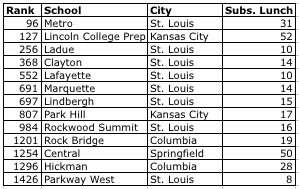
The perennial Newsweek best high school list compiled by Jay Mathews is out again. Valid criticisms of the list may be made, but the criteria is clear, is easy to understand and has changed the education landscape.
Only 13 schools from Missouri made the list, but at least that is up one from last year. In St. Louis Eureka dropped off the list, but Parkway West made it.
Kansas City only has one non-selective school on the list versus seven for St. Louis. There are, however, four high schools on the list on the Kansas City, Kansas side. Both high schools in Columbia made the list, which is impressive. The Springfield high school with 50 percent on subsidized lunch that made the list is not, as far as I can tell, selective. I believe that is the high school closest to the university, which may skew the subsidized lunch demographics, but those numbers are still impressive.
In 2005 St. Louis schools dominated the 10 schools from Missouri that made the list with only Lincoln College Prep, Hickman in Columbia and Park Hill in Kansas City rounding out the list. Lafayette in St. Joseph made the list in 2006, which would be nice to see return.
I think the geographical map of the top 1300 schools is interesting with a sea of blue on the coasts and in Florida.
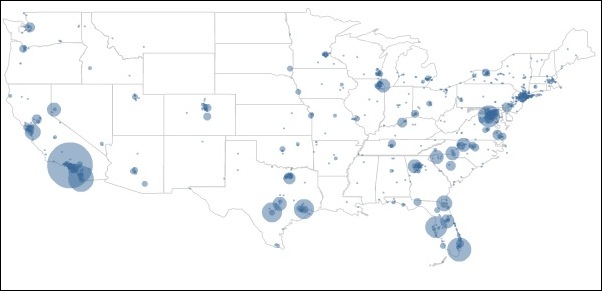
I zoomed in on Missouri and the surrounding states, which show blue in the urban areas with some pinpricks in some college towns.

With Missouri Virtual Instruction Program offering AP courses (pdf), students in rural schools now have more opportunities to take advanced classes. I would like to see more rural schools make the list.
Schools have to continually increase the percentage of students taking AP/IB exams just to stay on the list. For example, Ladue improved its index number from last year but dropped in rank. This is meant to be a “race to the top,” where the top means access to challenging courses for as many students as possible.
A new, non-researched phenomenom has begun in which some schools are all-out embracing the AP courses as a challenge for struggling students in coursework that doesn’t require prerequisites.
The rise of high-participation, low-passing-rate AP schools like Bell and Hogan has led NEWSWEEK this year to put them in a separate category, the Catching-Up list, for schools that have met the NEWSWEEK standard for college-level test participation but have AP passing rates below 10 percent. Once such schools pass the 10 percent passing mark, they will have about the same number of passing tests as the average American school, where passing rates are higher but participation is much lower. (AP Programs as Educational Shock Therapy)
Two high schools in Kansas City are using this approach. We’ll watch to see how they do next year.
Missouri ranges from 10 to 13 schools on the last from year to year. Next year, I would like to see that change and blown away.
Students taking AP classes in Mo., or not
My Humps—Calculus
Students in Missouri are not taking AP courses at nearly the same levels as in other states according to the College Board annual report released earlier this week (Wed. Feb. 13). In Mo. 10.6 percent of students take an AP class versus 24.9 percent national average. We're at less than half the national average.
Nationally, 15.7 percent of students earn a 3 or higher on at least one AP exam; whereas, in Mo. only 6.7 percent do. In fact, Mo ranks 46th. (Yeah, the College Board recommends against ranking for a lot of valid reasons, but I did I did it anyway.)
Last summer, Mo. DESE sent out a press release praising the uptick in numbers of students taking the exam.
❝This year we sent more money to Missouri classrooms than ever before and also secured funding to encourage even more students to take AP classes, including training for more AP teachers and assistance to help cover the cost of AP exams. It is clear by our students’ outstanding performance that our investments are helping our students prepare for the challenges ahead,❞ he [Gov. Matt Blunt] said.
However, the 2.0 percent increase in the past 5 years is quite a bit less than the national average of 3.5 percent increase. Our students are falling behind.
It's possible students here are taking AP courses but not the exam. Adding in IB classes wouldn't raise the rates much since only a few high schools here offer them (Lindbergh, Metro). However, I wonder if St. Louis University's 1-8-1-8 program decreases students motivation to take the AP exam.
I couldn't find numbers on students in Mo. taking AP courses, but I did look up a few districts' offerings to compare to the national average (9). Clayton offers 21 AP courses including Calculus BC, Music theory and Macroeconomics. Hazelwood offers 15 including Computer Science and Physics. I also looked up a rural district and chose DeSoto at random. I couldn't find evidence they offered any AP courses. I didn't see any listed in the course schedule (except possibly calculus); nor were any mentioned in the student handbook. They are proposing a college prep certificate starting class of 2010. If that is reflective of rural districts, Mo. is in trouble.
Missouri has started two centers at Truman and SeMo to help train teachers to teach AP courses. This is a good start but not enough.
Why go private? Income? Religion? Ivy League?
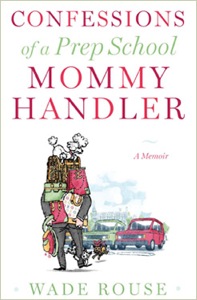
Region plays a large role in the private school rate as Mehlville and Affton have a higher private school rate than wealthier west county districts. It’s a Catholic area, baby! (Lutheran South may have a role in the numbers for Affton.)
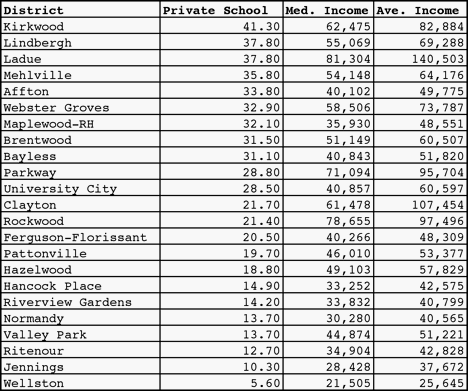
My theory is that the private school rate is dependent on multiple factors such as tradition, income and strong private school presences.
Ladue and Clayton are often considered sister schools with similar test scores, rankings, size, finances etc. However, the private school rates differences are striking. Yes, CBC moved to west county, but that was after the 2000 census. (Will these numbers change greatly in 2010?) I would have to dig more to figure out what Clayton and Rockwood have in common that is different than Ladue. I don’t know if Clayton’s numbers are related to the high number of people who walk or ride their bike to work, but I imagine Ladue’s high numbers are related to the two Ivy league feeder private schools within its borders. This is the land that inspired Confessions of a Prep School Mommy Handler by Wade Rouse.
Yes, of course, there’s a general correlation to income although the exceptions are more interesting.
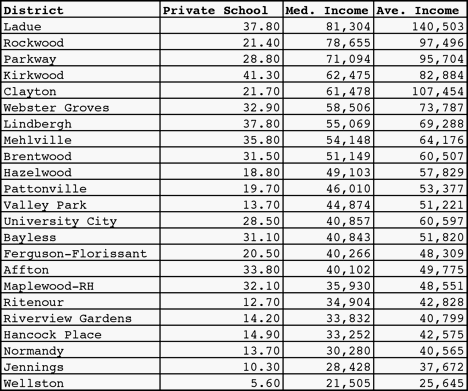
Look at Hazelwood and Brentwood with similar median incomes but different private schools rates or Affton and Ferguson-Florissant. I think the North County region just doesn’t have the tradition of attending private schools at the same rate. It’s not income there.
Why is Lindbergh’s private school rate (top 3) higher than it’s median income or quality would lead someone to hypothesize? I’m going back to the Catholic tradition.
Why is Kirkwood, a high quality school district, the number one private school sender? It’s not in the top three wealthiest by median or four by average. It’s numbers are more in line with Webster or Lindbergh. By tradition I would have put it with Webster, but, apparently, it aligns more with Lindbergh.
I have so many ideas for more posts now—how about that ranking of school districts by how many people go to work by walking or biking? Is there any significance that I can pull out from that? Who knew I could find census data so entertaining.
Mo bronze high schools don't have achievement gap; they just don't serve minority populations

❝A successful high school should show high levels of student achievement, graduate almost all of its students and not let any demographic subgroup lag far behind.❞
Mathews counters that
❝such criteria automatically exclude virtually any school serving large numbers of poor or minority students.❞
I think he's onto something.
Rotherham seems to focus on the forest:
❝Remember that when Sara Mead and I took a look at the performance of the top 100 Challenge Index schools on their state assessments we found average black - white gaps in pass rates of 26 points in reading and 31 points in math. One school had a 61 point gap in math!❞

A high school like Alton made the U.S. News and World Report bronze star list with only 37% proficiency in math and 33.9% in reading. Sure their discrepancy numbers are only 3.5 in math and 9.8 in reading, but with only 7 African-American students in the high school (1.8%) and such low overall proficiency numbers, is it really a best school? It does have a high percentage of free/reduced lunch students, Missouri does have a tough test, and the school should be commended for the job it is doing, but that doesn't mean I would send my kids there. Maybe I would—I don't know because these numbers just don't provide enough information. (The number of AP courses offered is more relevant for me as a parent.)
While policy wonks and politicians debate the achievement gap, parents want their kids to go to the best high schools for their kids, which is the purpose of the rankings. The St. Louis Black Leadership Roundtable, a group working with the St. Louis area school districts to decrease the achievement gap, found that the best schools for African-American students were not the ones with the lowest achievement gaps.
❝A telling conclusion of the report was that schools with the highest achievement levels among black students - such as Clayton, Webster Groves and Kirkwood - often also had the greatest gap in achievement levels between whites and blacks.❞ (BLR 2005 Education Report Card, link to actual report card not operable)
Clayton has a reputation as one of the top public high schools in Missouri and has high (for Missouri) proficiency numbers (70.2 math, 63.8 reading) and relatively high numbers for black students (37.3 math, 22 reading). Again, wide discrepancy numbers (43.9 math, 55.7 reading). The district and others like it should be praised for choosing to continue in the voluntary transfer program instead of kept off of best high schools lists at the same time encouraged to improve black students' achievement. I prefer to focus on improving a subgroup's achievement over focusing on the achievement gap since lowering overall achievement decreases the gap.
The U.S. News & World Report eliminated any school in Missouri with an ethnic population (except Metro and Lincoln College Prep, which are selective). That is not the way to encourage student achievement for all.
(Mo. high school numbers from the Mo. DESE School Data and Statistics Database)